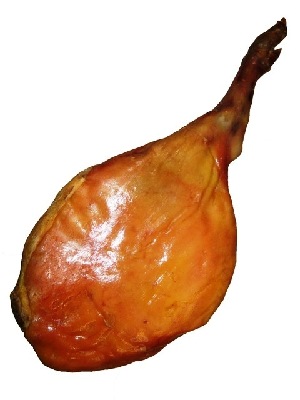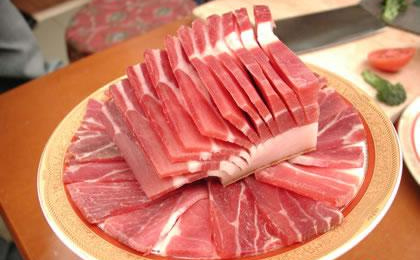| Home > China Feature |
Chinese Ham You Never Know Before
Chinese Ham You Never Know Before

Ham, which is cured by hog’s rare legs, is produced and sold around the world except for Islamic countries.
|
|
Chinese ham, known as huotui (red ham) in Chinese for its color, has a long history. The best-known ham is produced in Jinhua, Zhejiang province. Wang Mengyin, a famous traditional Chinese physician from the Qing Dynasty (1644-1911), expressed “hams from Jinhua, particularly in Dongyang, are not only delicious, but also good for our health. It is best to be cured with salt in the winter and preserved for more than two years.” Hams from Xuanwei,Yunnan, Anfu, Jingxi and Rugao, Jiangsu have also received a great reputation from people around China.
Different Kinds of Hams
Jinhua Ham
 |
Jinhua ham, salted with carefully selected rare legs from Jinhua hogs, is famous for its nice shape, fresh flesh and unique flavor and taste. With the complicated process of salting, shaping, washing and drying, Jinhua ham is the quintessence of Chinese cured meat. In the Qing Dynasty, it was paid as tribute to the emperor. Easy to preserve and transport, it sells well around the world.
Jinhua ham originated in the Northern Song Dynasty (960-1127) when Zong Ze, a famous general, carried hams from his hometown of Zhejiang to Kaifeng, Henan province, to encourage his soldiers. The hams were salted for better preservation. Soldiers called them “hams from hometown”.
Jinhua ham has various styles from their difference in materials, curing seasons and methods, such as hams cured in the winter, hams cured in sugar, smoked hams and crescent-shaped hams.
It has high nutritious value and has excellent pharmaceutical functions for people.
Xuanwei Ham

Xuanwei Ham, produced in Xuanwei county in the northeastern Yunnan province, has a history of more than 250 years. With its fragrant flavor and delicate taste, it enjoyed fast sales both at home and abroad.
Xuanwei is a paradise for curing hams for its Wumeng hogs and weather. It is best to cure hams in the cold winter and allow them to ferment for half a year. The salt coming from western Yunnan also contributes to the deliciousness of Xuanwei Ham. Shaped like lutes, it is also known as “lute pettitoes.”
Xuanwei Ham was originally made for Yunnan families and later became popular, selling around the world. In 1923, Sun Yat-sen tasted it at a food fair in Guangzhou, and lavishly praised the food.
Xuanwei Ham could be cooked in various styles such as stir-frying, deep-frying, steaming and stewing. Famous dishes include “luncheon meat of Xuanwei Ham” and “sliced Xuanwei Ham”.
Moon cakes stuffed with Xuanwei Ham is a traditional snack for Yuannan people during the Mid-Autumn Festival. It is salty, sweet, but not greasy at all.
Anfu Ham

Anfu Ham, which originated in Jiangxi, has a long history dating back to the Qin Dynasty (221-208 BC). Shaped like willow leaves, Anfu Ham has a fresh and tender taste and can be preserved for two or three years. Loaded with fat, protein, calcium, iron and various other amino acids, Anfu Ham has a high value for health.
Anfu Ham is so strict in choosing materials that only healthy hogs from northern Anfu county in the winter can be used. The whole process of washing, salting, fermenting, drying and preservation ensures a unique flavor.
It was praised and welcomed in the Panama International Expo in 1915 and was later presented at amrkets in Hongkon, Macao and Southeast Asia.
Art
 more
moreChina Beijing International Diet ...
Recently, The hit CCTV documentary, A Bite of China, shown at 10:40 ...

Exhibition of Ancient Chinese Jad...
At least 8,000 years ago, Chinese ancestors discovered a beautiful...

Longmen Grottoes
The Longmen Grottoes, located near Luoyang, Henan Province, are a tr...

Custom
 more
moreWeb Dictionary
Martial Arts
Tai Chi Master Class Held in Moscow
MOSCOW, June 15, 2016 (Xinhua) -- Students learn from Shaolin ...
Celebriting 70 years' efforts in restoring Mogao...
Work is being carried out at the restoration site of cave No 98 a...
Hong Kong Children's Symphony performs in Seattle
Under the theme of Tribute to the Golden Age, a concert featuring a ...





 print
print  email
email  Favorite
Favorite  Transtlate
Transtlate 








